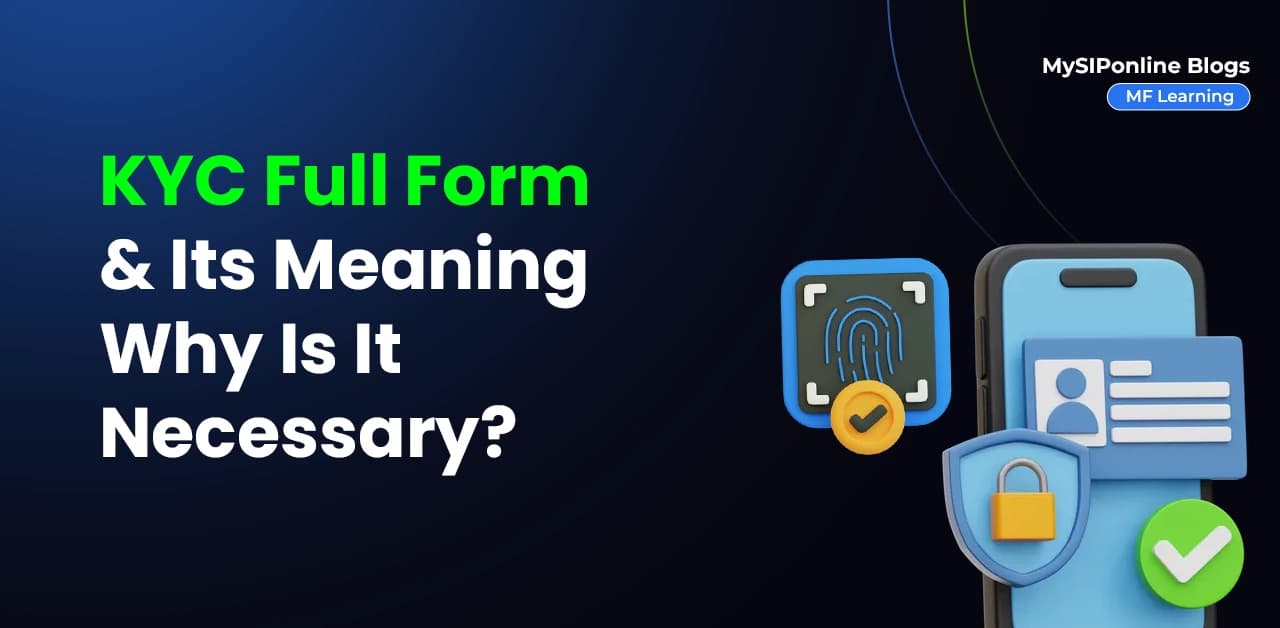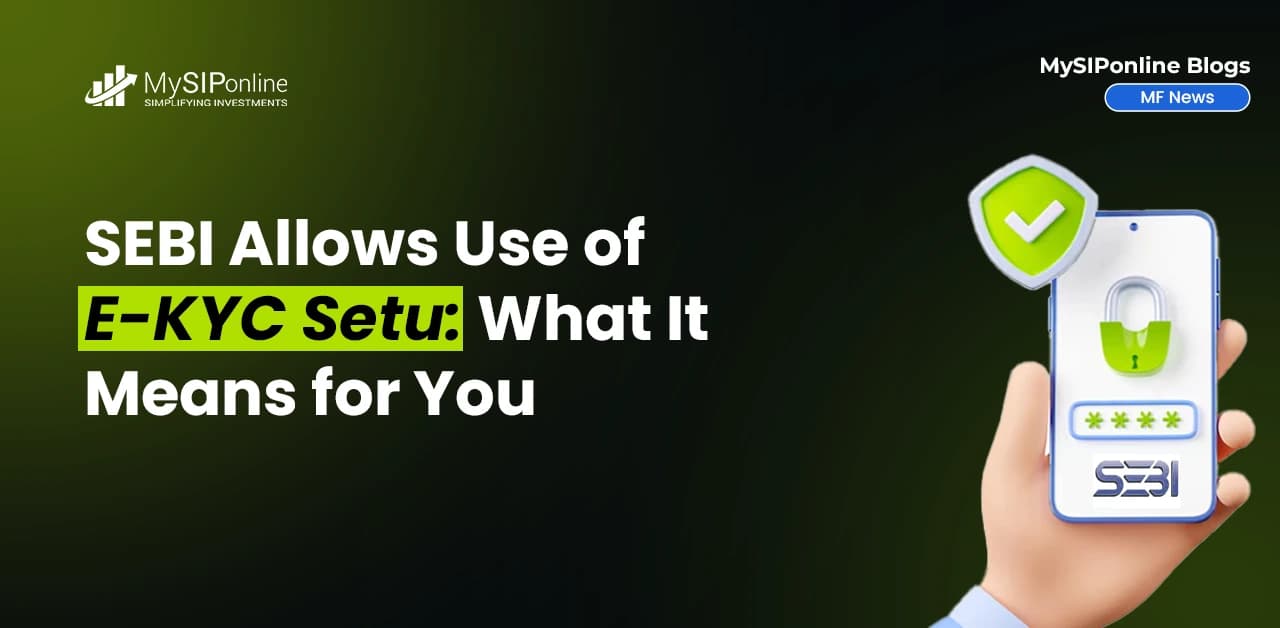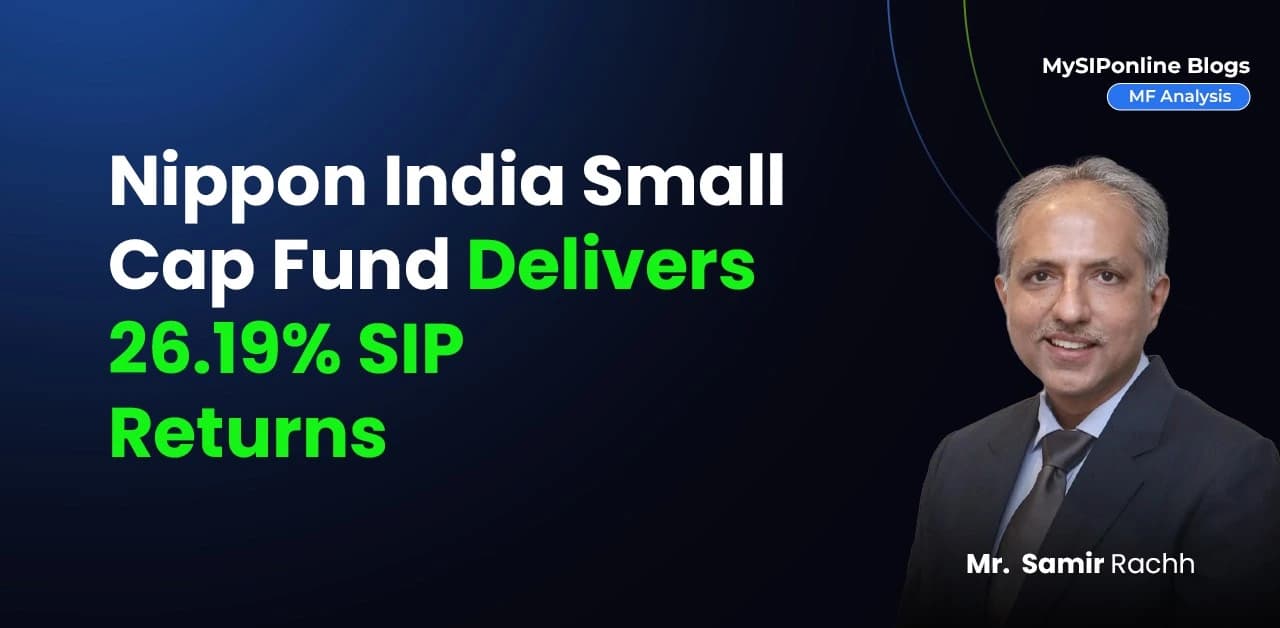Have you ever stumbled upon the phrase, KYC and wondered what is KYC full form? What does it mean and why is it important?
You have come to the right post if such questions pop into your mind. But first, KYC compliance is a mandatory process you need to complete before investing in Mutual Funds or even opening a bank account.
Yes, you can see it as a security check that proves your identity and works as the first line of defense against fraud and money laundering, which can harm your hard-earned money.
Now, let's move along to this complete guide, which will tell you everything you need to know regarding how KYC works, its benefits, types, and methods of doing online KYC and offline KFC. Let's get started.
What is the Full Form of KYC?
The KYC Full Form stands for "Know Your Customer." It is a process that mutual funds use to confirm the identity of their investors. This process has been around for a long time but has become more important in recent years because of the rising risk of financial crimes.
As the world becomes more connected and digital, it is easier for criminals to commit illegal activities, like money laundering. To prevent this, governments and SEBI (Securities & Exchanges Board of India) have put stricter rules in place, requiring businesses to follow KYC guidelines.
KYC also works hand-in-hand with Anti-Money Laundering (AML) efforts. These measures help businesses spot and stop illegal transactions by keeping a check on customer's or investor's activities and reporting any suspicious behaviour if found any.
This makes sure that your investments in mutual funds are protected from any type of financial crime or cybercrime.
Now that you have a full understanding of the KYC full form, let’s see what it means in mutual funds.
Start Your SIP TodayLet your money work for you with the best SIP plans.
What is KYC (Know Your Customer) in Mutual Funds?
KYC (Know Your Customer) in mutual funds is a process used by companies to confirm the identity of people who want to invest in mutual funds. This is done to make sure the person is who they say they are and to avoid any illegal activities like money laundering or fraud.
When you invest in mutual funds, you need to provide documents like your ID and address proof. This helps the company understand the identity of customers and makes sure everything is legal and safe. Once your KYC is complete, you can start investing in mutual funds without any issues.
Don’t Miss Out: Best SIP Plan for 3 Years
Purpose of KYC
The primary objective of a KYC is to verify the identity of its investor so that it can protect your investments from money laundering and financial fraud. The four main objectives of Know Your Customer (KYC) are:
- Customer Identification
- Risk Management
- Regulatory Compliance
- Trust Building
Insights into KYC Process
The KYC (Know Your Customer) process is a smart way for mutual funds to make sure their investors are who they say they are and to prevent illegal activities. Here’s how it works in simple terms:
- Investors On boarding: When a new investor signs up, the BSE collects basic information to verify their identity.
- Identification Program (CIP): It checks the investor’s personal details, such as name and birthdate and verifies them with official documents like a passport or driver’s license.
- Due Diligence (CDD): It also looks at the investor's financial history and where their money is coming from to assess how risky they are.
- Ongoing Monitoring: Keeps an eye on your transactions over time to make sure everything is legal and follows the rules.
- Reporting and Recordkeeping: Maintains a record of all the verification steps and reports any suspicious activity to the authorities.
These steps help mutual funds houses to follow the law and prevent illegal activities like money laundering.
Is it often when you hear Know Your Customer, what it means? Or what are the key components of the KYC process? Learn your answers in the next heading.
What are KYC 3 Components?
Here are the three main components of the KYC process:
- Customer Identification Program (CIP): The first step is to gather all the necessary information about your investor. It is mandatory as per CIP to verify and collect the investor's identification, name, date of birth, address proof and social security number (PAN or passport number).
- Customer Due Diligence (CDD): This step is more thorough and looks into your financial history, where you earn your money etc. It helps to know you are not involved in any illegal activity.
- Ongoing Monitoring: The Know Your Customer process continues even after the investor is onboarded. The mutual funds keep track of your transactions and make sure you comply with the rules and regulations set up by the government.
Importance of KYC in Mutual Funds
Now, after getting an understanding of the KYC full form, it is important for you to know the merits of doing a KYC:
-
Protection Against Financial Crimes
It helps in identifying and preventing crimes such as money laundering, terrorist financing and fraud. By verifying who investors are and checking their risk levels, it is easy to spot suspicious activities and take action before problems arise.
-
Regulatory Compliance
Keep your investments transparent and true, as it is mandatory for mutual funds or banks to strictly follow the KYC policy in a disciplined manner.
-
Strong Risk Management
Know Your Customer allows MFs to increase their efficiency to balance risk and be prepared for any kind of damage.
What are the 4 Pillars of KYC?
The four stages of KYC (Know Your Customer) are as follows:
- Customer Identification Program (CIP)
- Customer Due Diligence (CDD)
- Ongoing Monitoring
- Risk Management
Key KYC Documents List: You Must Know
The KYC documents required to start your mutual funds investment through online SIP or lumpsum are:
- Government-issued ID (PAN, Aadhar or driver's license).
- Proof of Address (bank proof or ration card).
- Tax identification number (social security number or national ID number).
- Business registration documents (birth certificate).
Note: these documents are used only to verify the investor's identity and make sure they are not on watchlists or blocklists to start investments purposes only.
When was KYC Verification Started?
The KFC verification process was started in the late 1970s in the United States (US). It was initially drafted as part of the Bank Secrecy Act (BSA) to fight money theft and money laundering concerns.
Since then, the KYC requirements have significantly changed. Notably, after the 11th terrorist attack in 2001, the government implemented several revisions after the Patriot Act and the financial crisis of 2008.
These new measures in the KYC policy were taken to enhance the security and safety of its customers. Today, KYC compliance is one of the strongest components in reducing cybercrime and upholding the integrity of the global financial system.
KYC Regulations & Compliance
One of the key benefits of KYC process is that it is required by the law to update KYC of its investors otherwise, heavy fines and legal actions can be the consequences.
Here are the key KYC regulations that every investor should know:
- The USA Patriot Act (US)
- The Bank Secrecy Act (US)
- The money laundering, terrorist financing & transfer of funds (Information on the payer) regulations 2017 (UK)
- The prohibition of money laundering act, 2002 (PMLA) (India)
What is KYC Verification?
KYC verification is an important step in preventing any financial crime. Moreover, if the IFC (International Finance Corporation) suspects any faults, it can lead to a damaging reputation, legal charges, fines or even jail time.
This is why the accuracy of the right KFC verification is very important to earn the trust of its customers or investors.
Smart Investments, Bigger Returns
Risk Connected with KYC Failure
The following points show the factors affecting the risk of inaccurate KFC verification:
- Legal Problems: Not following the rules can result in fines and legal trouble, sometimes costing millions of dollars.
- Financial Losses: If criminals use the bank to launder money or commit fraud, the bank can lose a lot of money.
- Damage to Reputation: If KYC checks aren’t done right, it can harm the bank’s image, causing customers to leave and other banks to take over. It could take years to rebuild trust.
In short, not doing KYC checks properly can lead to legal issues, financial losses and hurt the bank’s reputation, so it is very important for banks to have strong KYC procedures in place.
Role Played by Technology in KYC Verification
In finance, technological advances have made great strides and made the KYC process (Know Your Customer) more accurate, faster and safer for you. Let's break it into 4 simple steps:
- Automation: With the help of technology, collecting data, verifying documents and lowering risk have made the KYC process quicker and more consistent altogether.
- Accuracy: High-tech algorithms are used to determine whether the investor's data is valid, resulting in shorting human errors.
- Protection From Fraud: AI (Artificial Intelligence) and technological advances help identify mistakes at an early stage and resolve them immediately.
- Regulatory KYC Compliance: Technology helps update the system automatically on a regular basis, streamlining the whole KYC process to increase reliability.
Don’t Miss on: the Top 5 IT Sector Mutual Funds to Invest in India
Examples of KYC in Various Businesses
KYC is used in many different industries to check who customers are and stop illegal activities. Here are a few examples:
- Banking: Banks have to collect and verify information like your name, address and date of birth. They might also use things like fingerprint scans or background checks for extra security.
- Finance: Investment companies use KYC to make sure their customers aren’t involved in illegal activities like money laundering.
- E-commerce: Online stores may ask for KYC when you make big purchases or buy things from another country to prevent fraud and confirm your identity.
- Telecommunications: Phone companies use KYC to help customers get post-paid plans or buy expensive devices to make sure they can pay their bills and avoid fraud.
KYC helps Asset Management Companies keep things secure and follow the law.
Types of KYC in India
There are multiple types of KYC in India you should know:
- Paper-Based KYC: It is more of an offline KYC process that requires a physical visit to submit self-attested copies of bank and identity proofs to the KYC registration agency.
- Digital KYC: It is a modern technique that uses geotagged live photographs and officially valid documents (OVDs) online, which are cross-verified by the authorities. You can check the KYC status online.
- Video KYC: It is a paperless verification process that can be completed in minutes through a video call verified by the mutual fund agent.
- Aadhar-based eKYC: It uses remote authentication using UIDAI data and a one-time password (OTP) sent to an Aadhar-linked mobile number to verify the documents.
- Central KYC (KYC): Managed by the Central Registry of Securitisation Asset Reconstruction and Security Interest (CERSAI), allows a 14-digit KYC identification number (KIN) that is used to verify identity proofs if the investors and eliminates the need to submit the KYC documents.
How Can You Do KYC Online in India?
Here is a step-by-step eKYC process to ensure safety and security of its investors:
- Step 1: Choose your type of eKYC such as Aadhaar-linked or video KYC.
- Step 2: Upload all the necessary documents from your mobile to complete KYC verification.
- Step 3: Complete the authentication process with OTP sent to your registered Mobile number or biometric data.
- Step 4: At last, an agent to ensure the right KYC compliance does a manual review.
Must Read: Best SIP Plans for 1 Year: Grow Your Money Fast
How to Do KYC for Mutual Funds Online?
Here is how you can do an offline KYC before starting your investments in the Best Mutual Funds for 2025:
- Step 1: Visit the nearest bank to start the KYC verification.
- Step 2: Go with original copies and photocopies of PAN, Aadhaar card and bank proofs.
- Step 3: Fill out the KYC form appropriately and double-check before submitting.
- Step 4: Wait until your documents get verified by the agent.
- Step 5: Collect the acknowledgement receipt showing successful verification being done.
- Step 6: Wait until your bank confirms your transaction.
- Step 7: If you experience any delays, follow up on the matter for issues.
Best Practices for KYC (Know Your Customer)
Best practices for KYC (Know Your Customer) focus on using technology to make the verification process more accurate, faster and compliant with regulations. Here are some examples:
- Automating Data Collection: Use tech tools to gather and verify customer information automatically. It saves your time and reduces mistakes.
- Document Verification: It uses automated systems to quickly check if KYC documents are real and accurate.
- Risk Management: Use algorithms to spot risky behavior and flag any suspicious activities also helping to prevent fraud.
- KYC Compliance: Make sure KYC processes follow the law by using tech to stay updated on regulations.
- Continuous Monitoring: Use machine learning and AI to watch for unusual patterns in customer activity. It helps you to stop financial crime before it happens.
By using these methods, banks and financial companies can make sure their KYC process is accurate, quick and legally compliant.
To Conclude KYC in Mutual Funds
In short, you have mastered everything about the KYC process, from the KYC full form to how it works and the step-by-step process to successful KYC being done online and offline.
You might not know when an updated KYC will come in handy and protect your SIP investments from fraud and money laundering crimes.
Get your hands on more such expert insights :















